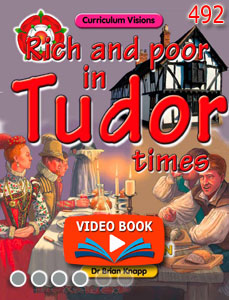What was England like when Henry VII, the first of the Tudors, became king in 1485?
England was a land of just 3 million people (49 million today) and there were three sheep to every person!
England had no big cities, and no big army or navy, because wars had left it too poor.
Life was much as it had been for centuries. But that was about to change...
The houses in a typical village - let's call it 'our village' - have been rebuilt many times since it was founded. But each time they were built of simple materials such as mud and thatch that don't stand the test of time. The buildings are not in orderly rows, but lie scattered about, each with a kitchen garden.
The only stone buildings are the church, rebuilt about two centuries ago, and the castle, where the lord still lives.
In early Tudor times most homes were simple and consisted of just a single room. They had changed very little for centuries.
The house had a wooden frame, often made using naturally curving tree branches. These were called cruck houses. The roof was thatch, the walls a mixture of mud, straw and cow dung - called daub - squashed into a lattice of willow stems - called wattle, and the floor was simply earth.
In Tudor times, the market was becoming more important.
During Tudor times people became wealthier and markets changed from a few times a year to every week or even every day.
A Tudor market was more like a 'boot sale' where market stalls gave local people and outsiders a chance to sell all kinds of things, both good and bad, old and new, from pigs and clothes to spices.
By 1600 things were very different...
Land changed hands under Henry VIII and those with land grew richer under Elizabeth.
In our village the yeomen and merchants used this wealth to start to rebuild their houses. This time is called the Great Rebuilding.
Some extended and modified their houses, others rebuilt them entirely, using good materials.
But the poor missed out...
Remember, more wealth and the invention of chimneys led those with enough money to rebuild their homes to give themselves more rooms and more space - the Great Rebuilding.
For the first time we see bedrooms on upper floors and smokeless rooms, with the smoke directed up the chimney and not left to fill the whole house.





